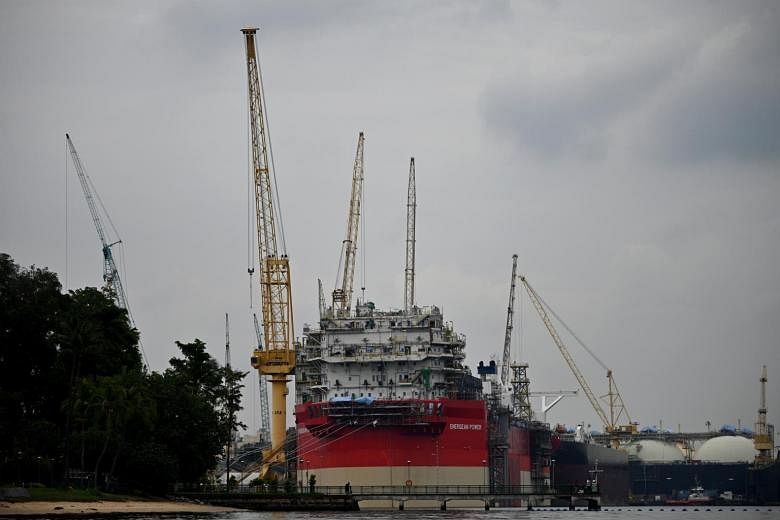SINGAPORE - The marine and offshore sector is facing challenging times, but it can still pivot to new areas for long-term growth, said Minister for Trade and Industry Chan Chun Sing on Monday (Nov 9).
During a visit to marine engineering firm Sembcorp Marine, he noted: "It is perhaps a natural effect of the industry that every so many years, there will be a cycle of peak and trough. Unfortunately, we are going through a trough of the cycle so the conditions are very challenging.
"But having said that, I want to have us just to remember... this is a industry that is very engineering-intensive. It requires us to build up capabilities and skilled workers over the long haul. This is the reason why we are not just going to manage the short-term ups and downs, but more importantly, we have a plan to make sure that we help our industries and workers to continue to do well over the long term."
Efforts by the industry to transform even before the pandemic have already started paying off, noted Mr Chan. Annual orders won by Singapore marine and offshore firms grew from $820 million in 2016 to $4.5 billion last year.
The marine and offshore sector here includes services that Singapore provides to meet the worldwide demand for ship repair, shipbuilding, rig-building and offshore engineering, as well as oilfield equipment manufacturing, and the building and chartering of offshore supply vessels.
It employs close to 77,000 workers and is anchored by Keppel Offshore & Marine, Sembcorp Marine and ST Engineering Marine. These firms are supported by a network of small and medium-sized enterprises (SMEs) that supply the yards with manpower and other components.
Mr Chan noted that due to the pandemic, the industry is being hit by a sharp fall in the global demand for oil because of the reduction in air travel and transportation.
This year, the International Energy Agency estimated that global demand for oil will drop by about 8.4 per cent, which is the largest fall in history. Production is also expected to fall to a 15-year-low.
"Because of this, the (limited) demand for offshore rigs, with the cancellation or delay of the existing projects, will therefore threaten the oil rig building industry. It is therefore important for our industry to have the engineering capabilities to pivot to new areas," he said.
Firms can continue to move into new growth areas, he said, such as liquefied natural gas (LNG), offshore wind and smart and digital products.
Singapore firms secured $1.5 billion and $1 billion worth of LNG and offshore wind-related projects respectively last year.
Mr Chan said: "The demand for the conventional oil rigs has come down over the previous years, and the industry has used existing capabilities to pivot to new areas like offshore wind.
"Another growth opportunity is the shift towards LNG, which is probably at this point in time, the cleanest fossil fuel energy source that we have. So the longer term outlook for LNG is still bright, because of its relatively lower costs and relatively lower emissions."
He noted that Sembcorp Marine has built a gas innovation and solutions centre to focus on design and engineering capabilities for LNG bunkering vessels, among others.
"With the reduction in our local manpower pool and also the constraint on foreign manpower pool, (our industry) has heavily invested in productivity initiatives that leverage much more on good upfront design, additive manufacturing processes, robotics and automation," he added.
Since 2017, the sector committed more than $350 million in state-of-the-art production technologies, with the three key firms investing in measures to improve productivity.
Firms have also invested in upskilling workers, with Sembcorp Marine grooming staff in areas through postgraduate programmes. Keppel Offshore & Marine sent 134 staff for professional conversion programmes so they can be redeployed to new roles.
"Today, the industry is competing on the basis that it has the design capabilities and quality assurance that can allow the shipyards in Singapore to integrate parts of the productions from all around the world to be assembled and qualified in Singapore. And that is how we make a mark for ourselves," Mr Chan said.
"So notwithstanding the short-term challenges, we still see prospects of this industry going forward, (with) the new areas of engineering solutions required by the rest of the world. We have every intention to make sure that we continue to support this industry, and the ecosystem of SMEs that are supporting this industry, so that we can distinguish ourselves through these difficult moments."


